Shichi-Go-San: A Celebration for Children Ages 3, 5, and 7 in Japan
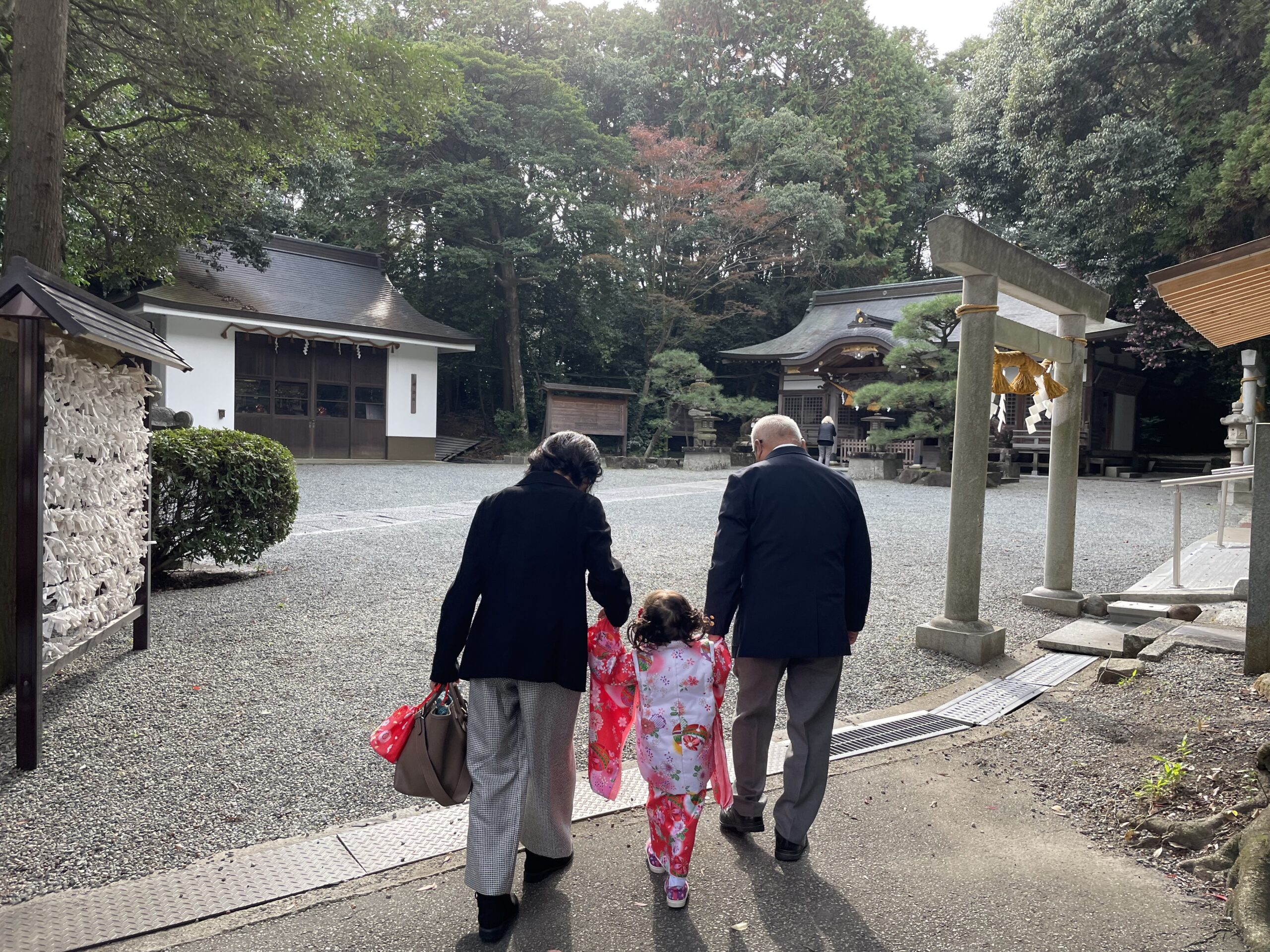
Last Updated on September 25, 2025 by Kay
This post may contain affiliate links, meaning I may earn a small commission on any purchases through those links at zero additional cost to you. Whatever I make goes to keeping this website running and I am forever grateful for the support. See my Privacy Policy for more information.
One thing I love about Japan is that there are many celebrations for children, such as Omiyamairi, Okuizome, and Shichi-go-san. As my daughter celebrated her first Shichi-go-san this month, I’d like to share our experience and the background of this Japanese tradition.
Table of Contents
What is Shichi-Go-San?
Infant and child mortality was high in the distant past, meaning that reaching the lucky ages of 3, 5, and 7 was something to be celebrated in Japan. This celebration is called Shichi-go-san (七五三), which stands for 7 (shichi・七), 5 (go・五) and 3 (san・三). This is sometimes written as 753 as well.
On Shichi-go-san, children who turned 3, 5, and 7 by April of that year get dressed in kimono (for girls and boys) or hakama (for boys) and go to a shrine with their family to pray for their continued good health and well-being. Usually, both girls and boys celebrate Shichi-go-san when they’re three, but only boys celebrate this occasion when they’re 5 and only girls when they’re 7.
Why the difference? Well, one reason is that in the Edo period (1603-1867), boys began to wear hakama for the first time at the age of five while girls began to wear furisode at age seven. (I’ve also read that girls at seven start to wear kimono tied with an obi rather than just a sash and 被布コート (hifu coat), a type of vest, on top.)
However, both boys and girls celebrate at three as this is when children begin to grow their hair out. (In the past, babies had shaved heads to promote hair growth.)
Note that there are also regional variations when it comes to how children celebrate Shichi-go-san. It’s believed that this tradition originated in Kanto during the early Edo period before spreading to other areas in Japan. This is why Shichi-go-san tends to be celebrated more elaborately in Kanto while in other areas, such as Kansai, sometimes people just skip the prayer at the shrine altogether and just get chitose ame, a stick candy in the Japanese celebratory colors of white and/or red (although it looks more pink).
Chitose ame, written as 千歳飴 in kanji, translates to “a thousand-year candy” as it symbolizes longevity.
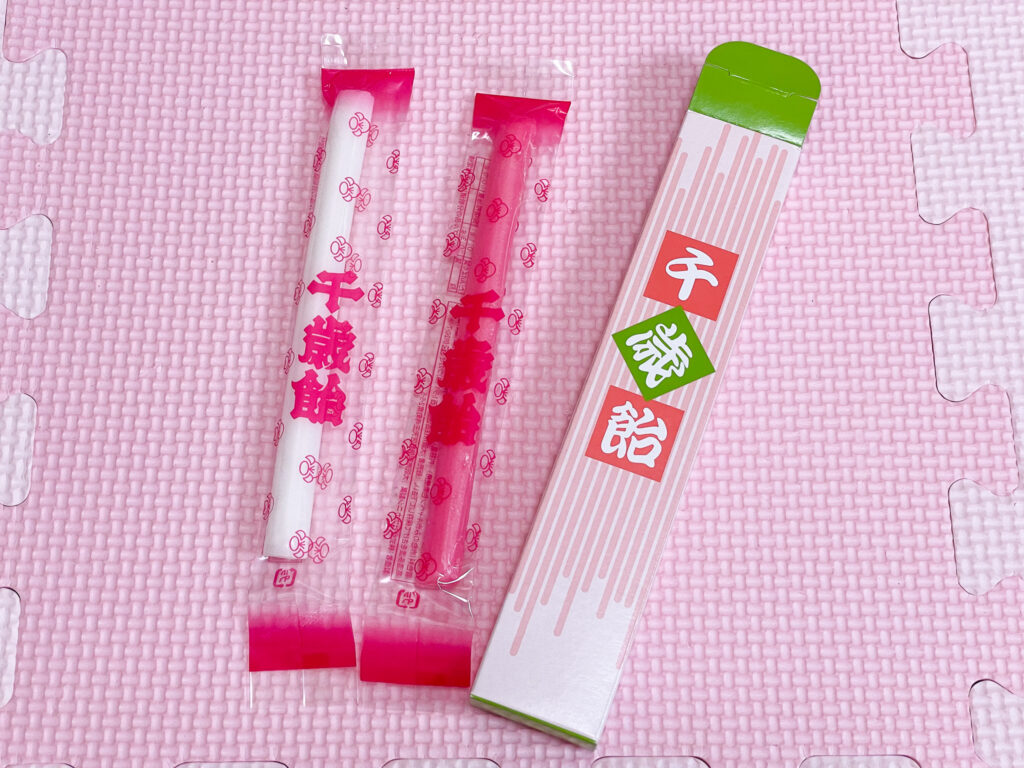
There are also areas in Kanto where only three-year-old girls celebrate Shichi-go-san.
When is Shichi-Go-San?
Shichi-go-san is celebrated on November 15. However, this doesn’t mean that it must be celebrated on that exact day. In fact, many shrines conduct the prayer for Shichi-go-san from mid-October to November, and several times a day.
Children also typically get professional photos taken at a studio, which can occur as early as June. I’ll explain more about this in the following section.
To Rent or Buy a Kimono or Hakama for Shichi-Go-San
When it comes to the kimono and hakama for Shichi-go-san, you can either buy or rent. Kimono (worn by both girls and boys) and hakama (boys) made out of quality material will set you back quite a bit (around 100,000 yen), but you can buy new polyester sets for around 10,000 yen.
If you go with the buying route, you’ll either have to know how to put on the clothes yourself or find someone to do it. However, you don’t have to worry about things like it getting damaged, booking a specific time and date to rent the kimono, and returning it on time as it’s yours! It can be a nice investment if you plan on having another child, too. Afterward, you can always sell the kimono or hakama on resale sites like Mercari.
You also have the option of renting these traditional clothes from the photo studio and/or shrine.
Rental includes kitsuke (dressing) as well as hair and makeup, and with photo studios, you can get discounts if you book in advance alongside a photo session.
Here are some popular photo studios across Japan where you can rent kimono for Shichi-go-san and have professional photos taken:
My daughter’s kimono rental, including insurance in case she stained it, was 17,000 yen and… later I discovered the exact same kimono on Amazon for much less!
But when considering that the studio would have charged us for bringing our own kimono anyway, not to mention the price of kitsuke as well as hair and makeup, it was kind of those “oh well, we didn’t lose too much” situations. Of course, if you don’t mind doing your own kid’s hair and putting on the kimono (which isn’t very hard when they’re three), then I recommend just buying a set from Amazon.
Kimono for three-year-old boys from Amazon Japan
Note that your child does not have to wear traditional Japanese clothing for this event! My husband’s cousin put her kids in simple dresses and there was no problem with that. It’s completely up to you!
Taking Shichi-Go-San Photos at a Studio
Back in July, my husband and I decided to check out studios for our daughter’s Shichi-go-san photos. I highly recommend visiting several studios, if possible, to help you get an idea about the staff, the location, the types of outfits they have, and any special deals they’re offering.
Photo studios throughout Japan offer cheaper packages in the summer that allow you to book a kimono and a hakama at a discounted rate for the fall. One studio also offered birthday photos with the Shichi-go-san photos for children born in July, but we were too late to snag that bonus, unfortunately.
We narrowed down our options to Studio Caratt, which has several branches throughout Japan. The price was reasonable, the dresses and the kimono were cute, the staff were very friendly, and I liked the different sets in the studio.
We decided on a package that included two outfits, a kimono rental for the shrine visit (omairi・お参り), a family photo shoot including kimono/hakama, and we would receive all the data. We wouldn’t get any physical photos but we figured we could print out any photos we liked on our own.
With Studio Caratt, we were not able to reserve the dress or kimono for the photo shoot, only the kimono for the omairi, but luckily, both of the ones I had my eye on were available on the day of the shoot — a pretty pastel dress with ruffles and a Jill Stewart floral kimono in a natural-type pattern, which was all the rage that year.
The photo shoot started with the dress first. My daughter got her hair and makeup done before putting on her dress, which she had no problem with (perhaps because she got to watch Moana). When the staff put a tiara on her head for the finishing touch, I almost cried. She had transformed into a little princess! And oh how adorable and beautiful and perfect she looked!
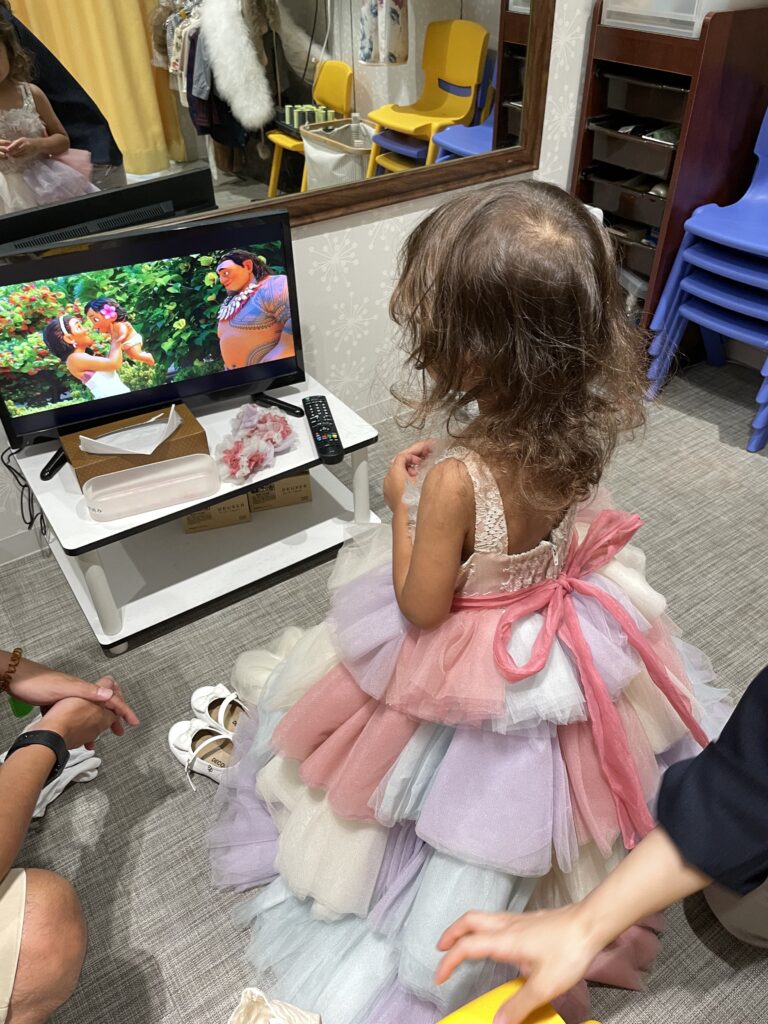
I should mention that Studio Caratt, or at least the branch we went to, does not allow parents to take a photo or video of the child getting ready. However, taking pictures and videos of the shoot itself is completely fine.
My daughter was nervous in the first photo shoot and it showed but she tried her best to follow the photographer’s instructions. I love her awkward little smiles, though.
In the meantime, my husband got changed into his hakama for the family photo shoot.
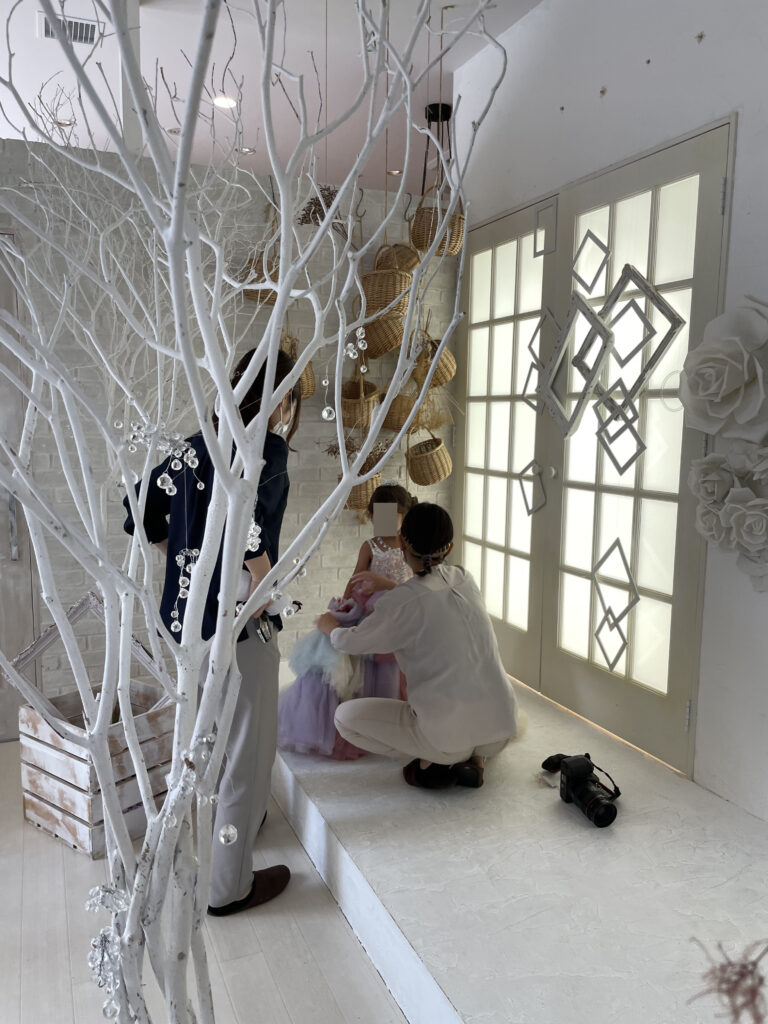
Some of the poses in this shoot included lying down with the bottom of the dress underneath, sitting with 753 blocks on the dress, pointing at things, holding a bouquet of flowers, and doing cute poses in various spots.
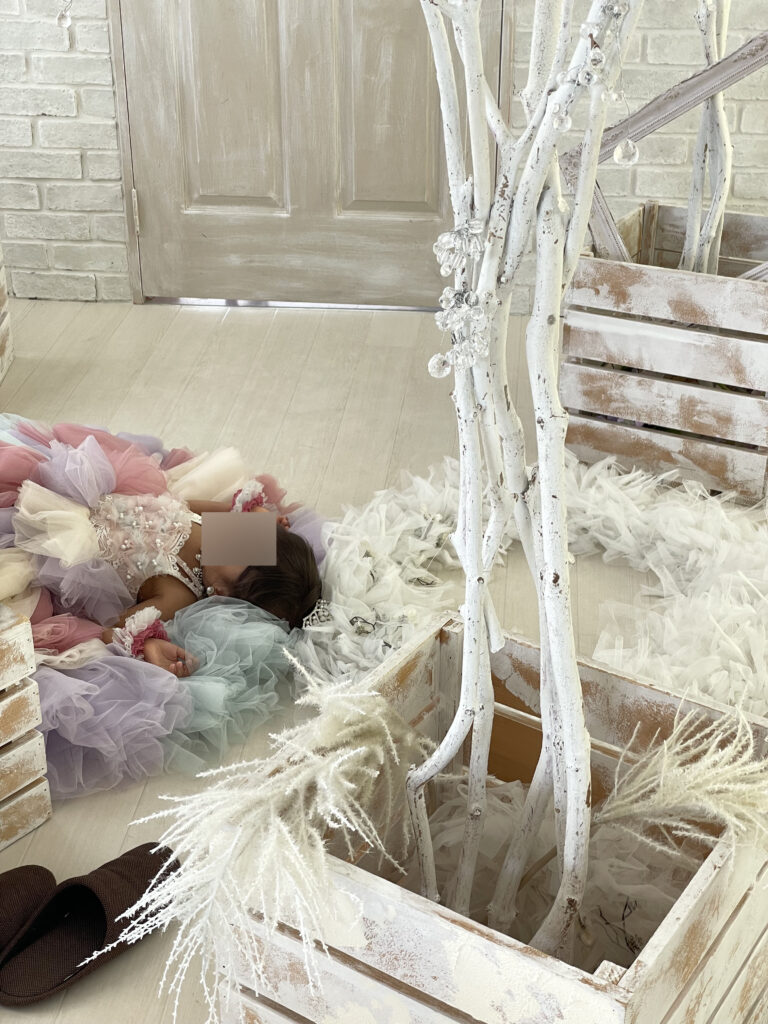
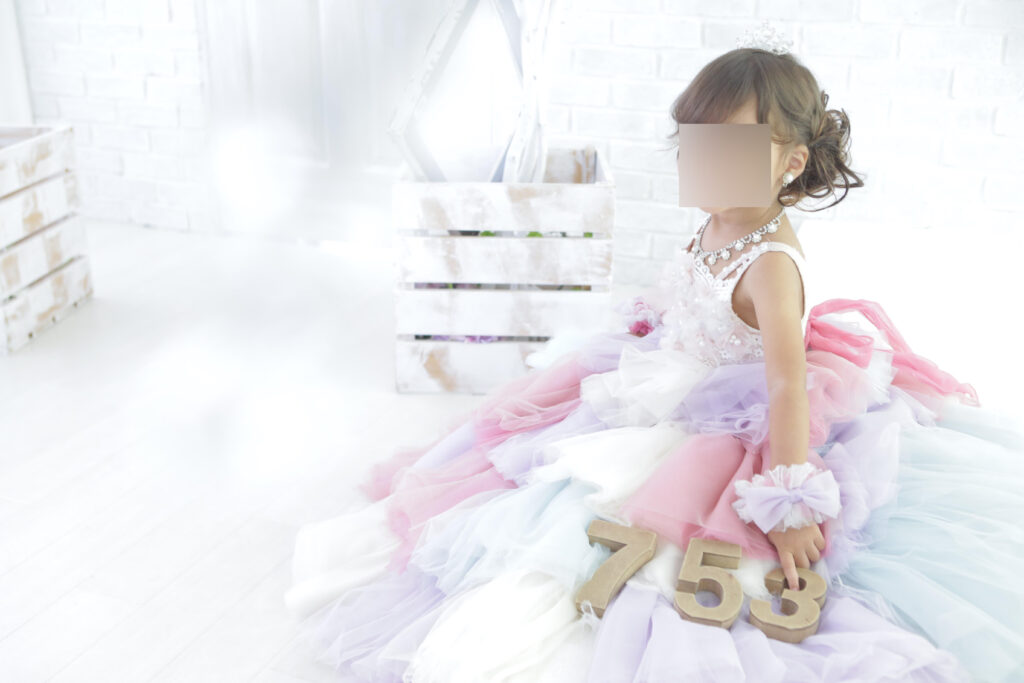
When it was time for the kimono photo shoot in another part of the studio, I got changed as well. My kimono and hair took quite a bit of time so in the changing room, I could hear my daughter crying for me at the start of her kimono photos.
She was all smiles when I came out though. Another staff member brought out an Anpanman toy and pressed buttons on it while running away and making funny noises, which successfully brought out natural smiles and laughter in my daughter. (The photos of this session definitely show it!)
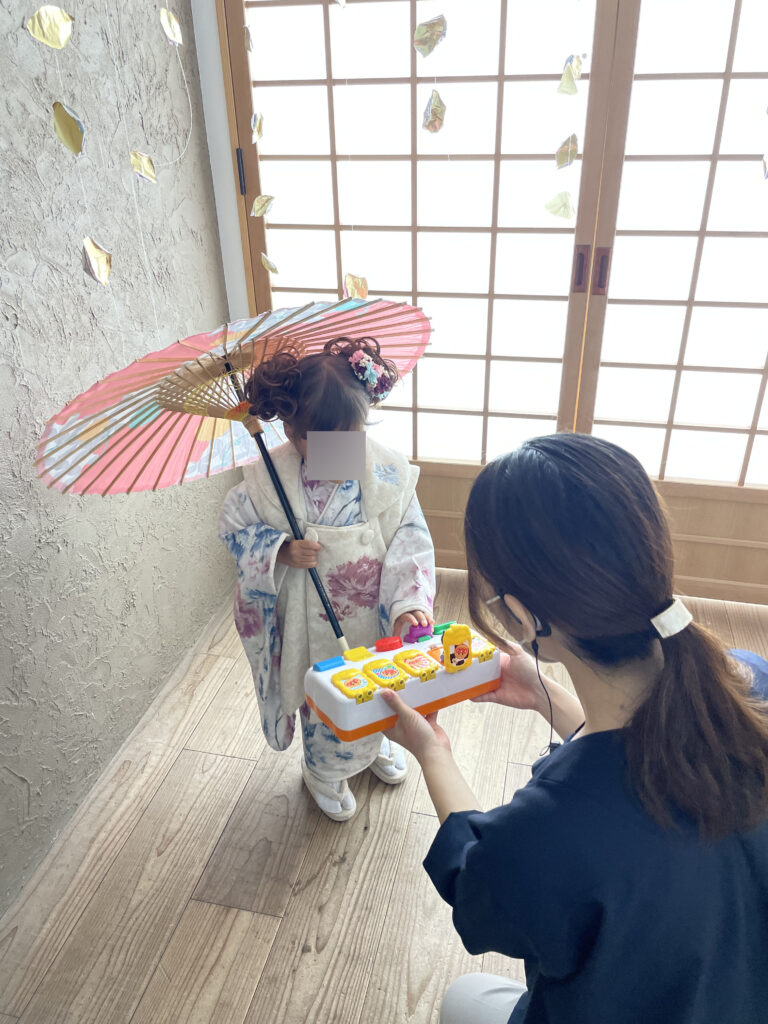
This shoot included holding things such as a pretty long rectangular paper bag with 千歳飴 (Chitose Ame) written on it, a small Japanese bag called kinchaku (巾着), and a wagasa (Japanese umbrella). She also had photos in front of a shoji (a Japanese-style sliding door) and sitting with 753 wooden numbers next to her.
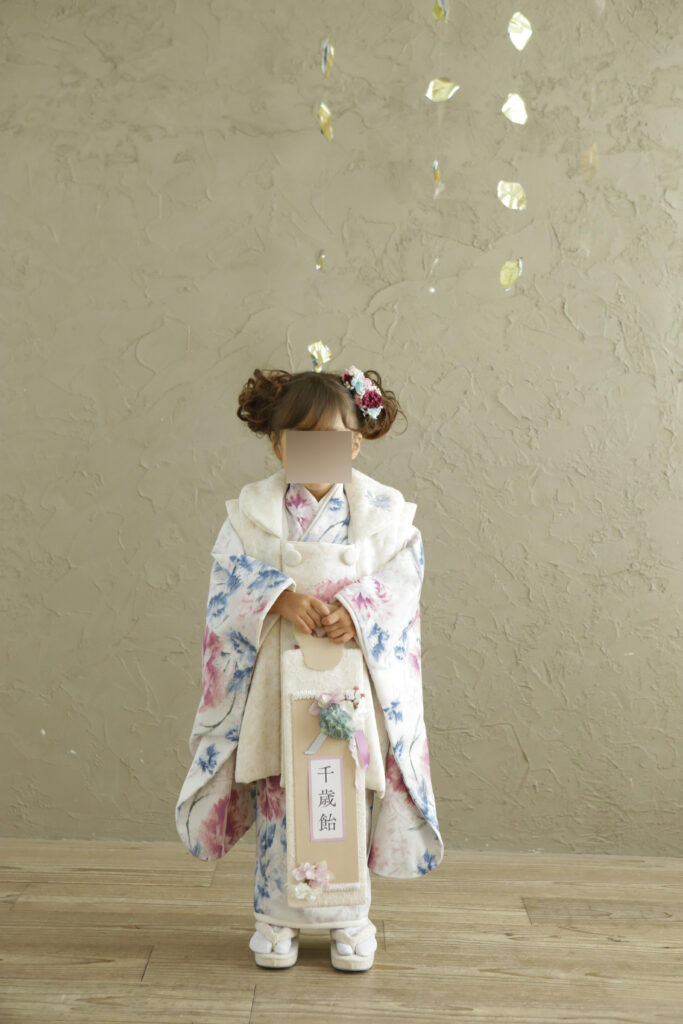
Lastly, it was time for the family photo session. My daughter was getting restless at this point but she still did a good job. Looking back, I wish I had worn blush or eyeshadow but my skin was so sensitive at the time that I didn’t want to risk it.
Overall, the entire session took about 1.5 hours, from 10:00 AM to 11:30 AM.
Visiting the Shrine for the Shichi-Go-San Prayer
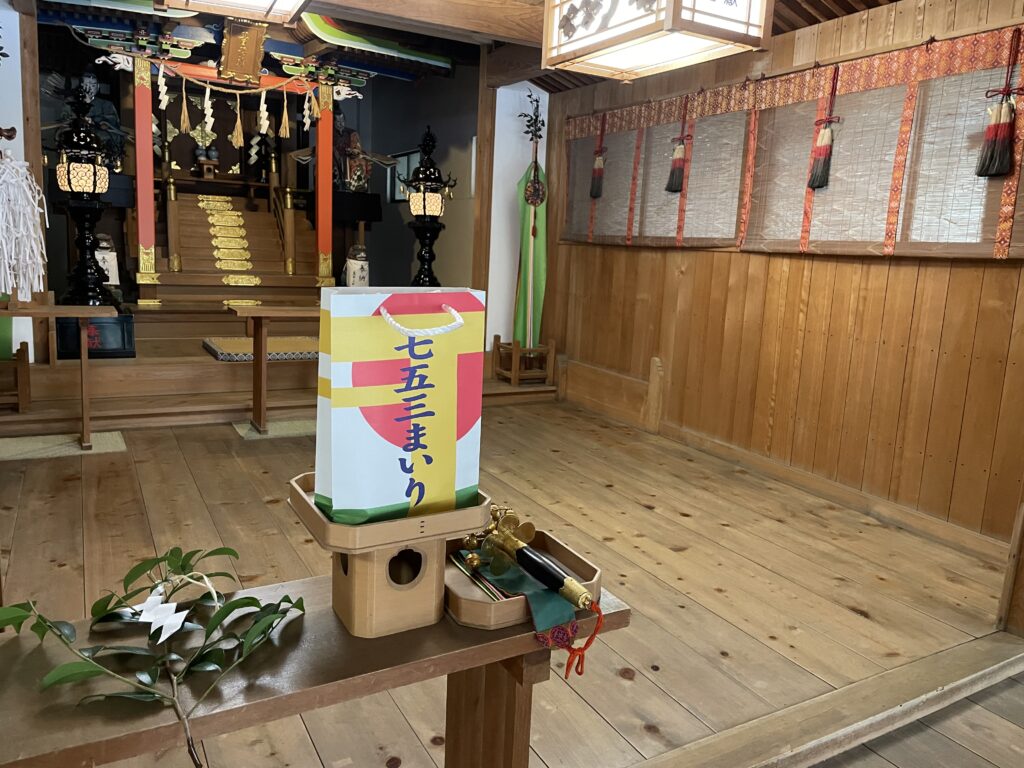
When it comes to the shrine for having the Shichi-go-san prayer (七五三の祈祷・shichi-go-san no kitou) , make sure you check in advance about their system as each shrine is different. Some require you to reserve in advance, some have specific times that they do the prayer, and for others, you can show up whenever!
The fee for the prayer, called 初穂料 (hatsuhoryou) or玉串料 (tamagushiryou) also varies depending on the shrine. We spent 6000 yen but some other shrines quoted 8000 yen or more.
You can have the prayer for Shichi-go-san at almost any shrine but some are more specialized for this occasion than others, meaning there may be more decorations, banners, photo spots, kimono/hakama rentals, and even photographers.
We decided to go with a local shrine as we liked how it looked (up on a hill and surrounded by coniferous trees), we didn’t want a shrine with too many people, and it was the most affordable.
We booked a time and date in mid-November. My in-laws decided to join us for this occasion so in the morning after they arrived from Hiroshima, we drove to the photo studio to get the toddler changed into her kimono.
I decided to opt out of wearing a kimono myself as I wanted all the attention to be on my daughter and didn’t think I would have the energy to put away my kimono at the end of the (guaranteed to be busy) day, so instead, I wore a formal black dress and got my hair done at a salon.
When my daughter and I were ready, we headed straight to the shrine. As it was a weekday and the shrine was in a somewhat remote location, we were the only guests.
The shrine was small with seats for only eight people, which was perfect for the five of us. My husband and I sat in the front with our daughter in the middle. She was very calm and quiet, a stark contrast to when she had her Omiyamairi when she was three months old.
The Shinto priest began the prayer, which consisted of:
- 修祓 (Shubatsu)
The priest chants while the attendees keep their heads bowed. The priest also purifies the attendees using an oonusa (大幣), which is a stick with many folded pieces of washi paper on it. - 斎主 (Saishu)
The attendees stand up and bow once alongside the priest. - 祝詞 (Norito)
The priest chants again, praying for the health, growth, and happiness of the child. - 玉串拝礼 (Tamagushihairei)
The child (with a parent if needed) places an offering called 玉串 (tamagushi) on the altar. This is in the form of a folded piece of washi paper on a leafy branch of a sacred sakaki tree. The branch is like a plate or vessel for the washi paper, which is the true offering. - Closing remarks
My daughter was very good about sitting quietly during the prayers and she even gently put her hand on my arm to stop me from taking photos! She’s the reincarnation of someone’s grandma, I’m telling you!
Keep in mind that there are differences in how this prayer is held according to the shrine, so what we experienced is just one example.
At the very end, my daughter was gifted with a bag of goodies from the shrine, which contained the following:
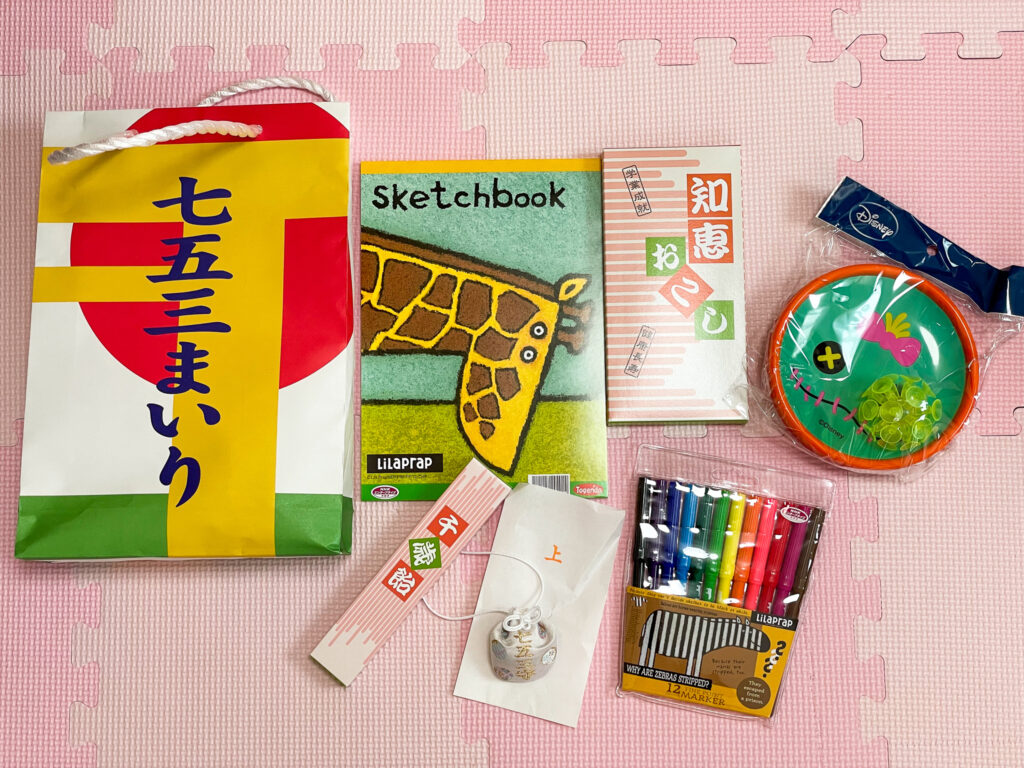
You might notice the 千歳飴 box in the middle of the photo above, right under the sketchbook. I thought the candy would be quite hard, like a candy cane, but it’s softer and quite chewable.
Taking Professional Shichi-go-san Photos Outdoors
Afterward, we took photos at a nearby location with a freelance photographer whom we had booked prior on fotowa.
My daughter did not want to wear the zori at this point and just kicked them off, so she ended up just wearing her Paw Patrol shoes. (For those of you who have yet to do Shichi-go-san with your child, I would recommend bringing a nice pair of shoes for them just in case they do the same!)

The photographer was great and the shoot was the perfect amount of time as my daughter started to get quite tired once the 45 minutes were up. The photos were absolutely gorgeous as we chose a location filled with Momiji trees. I’m also really happy that we got professional photos in with the grandparents as it’ll be a nice memory for my daughter to look back on.

If you’re interested in hiring a freelance photographer for your child’s Shichi-go-san, I absolutely recommend fotowa. I’ve used photographers from there in both Tokyo and Osaka and I’ve been very pleased with the service. I wouldn’t recommend it if I wasn’t!
If you want to read more about fotowa, I’ve written a post about my experience using it so have a look!
Famous Shrines for Shichi-go-san in Kanto and Kansai
If you’re wondering which shrine to visit for this event, here are some popular ones in Kanto and Kansai.
Famous Shichi-go-san Shrines in Kanto
(Tokyo, Chiba, Saitama, Kanagawa)
日枝神社 Hie Jinja (Tokyo)
明治神宮 Meiji Jingu (Tokyo)
神田明神 Kanda Myojin (Tokyo)
大國魂神社 Ookunitama Jinja (Tokyo)
富岡八幡宮 Tomioka Hachimangu (Tokyo)
花園神社 Hanazono Jinja (Tokyo)
稲毛浅間神社 Inage Sengen Jinja (Chiba)
伊勢山皇大神宮 Iseyama Kotaijingu (Kanagawa)
寒川神社 Samukawa Jinja (Kanagawa)
氷川神社 Hikawa Jinja (Saitama)
Famous Shichi-go-san Shrines in Kansai
(Osaka, Kyoto, Nara, Hyogo, Wakayama, Shiga)
住吉大社 Sumiyoshi Taisha (Osaka)
豊國神社 Hokoku Jinja (Osaka)
北野天満宮 Kitano Tenmangu (Kyoto)
下鴨神社 Shimogamo Jinja (Kyoto)
生田神社 Ikuta Jinja (Kobe)
射楯兵主神社 Itatehyouzu Jinja (Himeji)
近江神宮 Oumi Jingu (Shiga)
白鬚神社 Shirahige Jinja (Shiga)
春日大社 Kasuga Taisha (Nara)
橿原神宮 Kashihara Jingu (Nara)
熊野那智大社 Kumanonachi Taisha (Wakayama)
竈山神社 Kamayama Jinja (Wakayama)
If you’re not sure about whether there’s a shrine near you for Shichi-go-san, look up shrines (神社) and Shichi-go-san (七五三) on Google with the name of your city/town, or Google maps. Most shrines have a website where there will be information about which ceremonies they provide.
You can also call them or go straight to the shrine and ask in person. Sometimes you might even see some flyers about it in your neighborhood, like @clairparfait, an American mom in Japan, did!
This is not a sponsored post.
Also, there’s been a rise in articles using content from my website but not crediting it. If you find the information here helpful, please do the right thing and credit it.
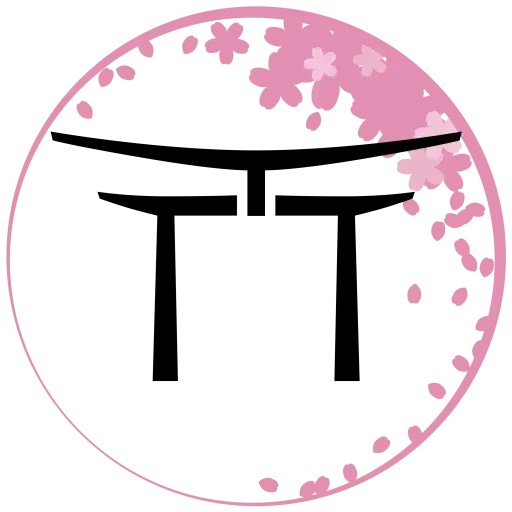
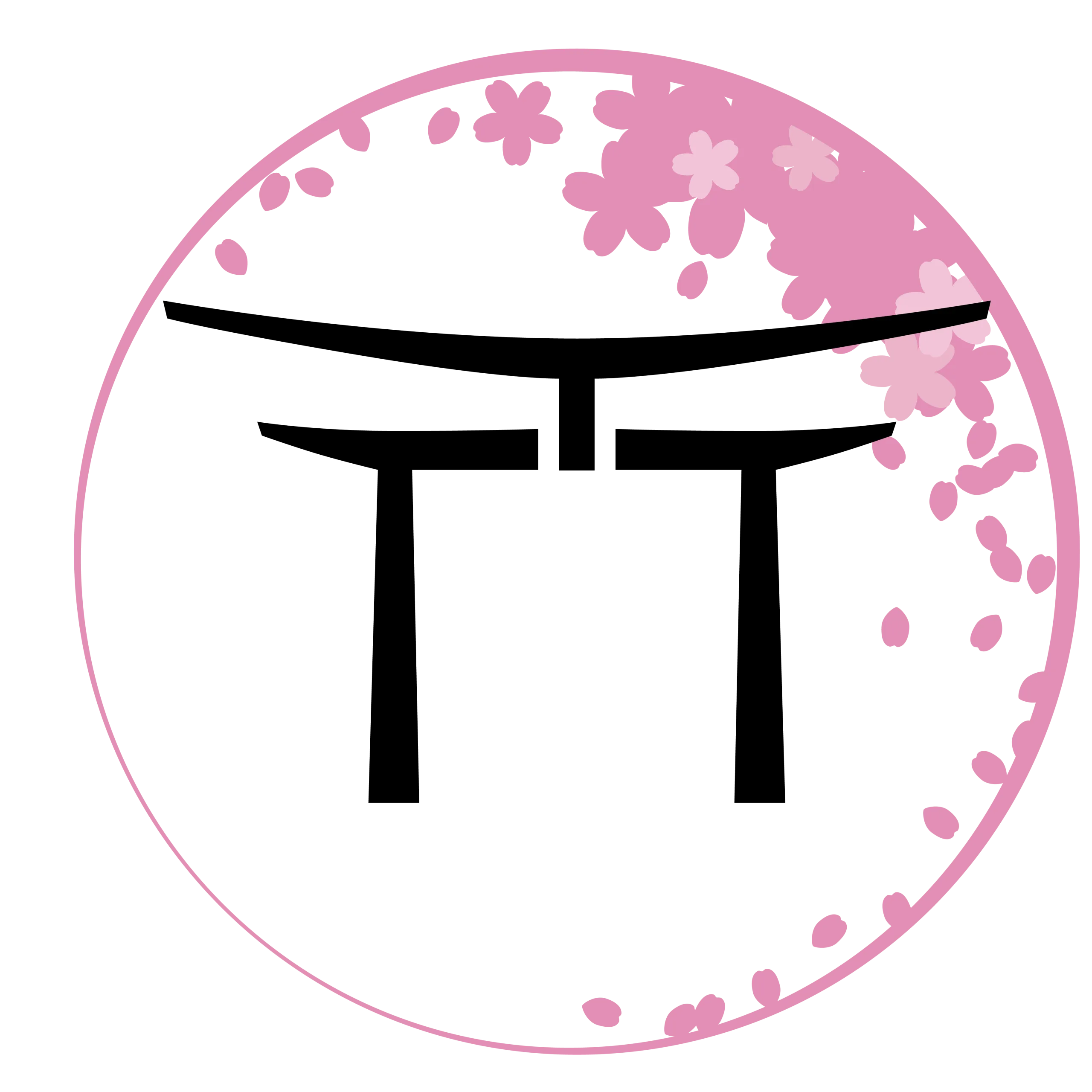
![[KYOETSU] [キョウエツ] 着物セット 七五三用 3歳用 被布セット 華やかA 9点セット(柄被布、柄着物、伊達衿、長襦袢、髪飾り、巾着、草履、腰紐、足袋) ガールズ (1.紅の花舞)](https://m.media-amazon.com/images/I/41wAERt60gL._SL250_.jpg)
![[KYOETSU] [キョウエツ] 七五三 3歳 着物 男の子 被布 フルセット しちごさん (4.紺無文,](https://m.media-amazon.com/images/I/31MHiIJzZ4L._SL250_.jpg)